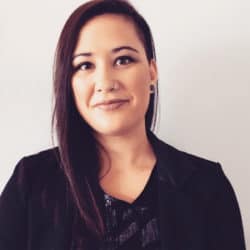This Q&A is part of a series of interviews with six PhiLab researchers about their areas of study.
This Q&A is part of a series of interviews with six PhiLab researchers about their areas of study. PhiLab is a Canadian research network on philanthropy based in Montreal, on the campus of UQAM.
***
Adriana Davis, bachelor of arts, University of Regina (psychology and sociology)
You competed in track and field for five years. How did that period of your life influence you?
Those years definitely helped me succeed in the projects I am working on today. Being a student athlete helped me learn to manage my time effectively. I also developed the determination I need today to make sure that my work and my contribution are up to the standards expected of me.
You were able to break a track record. Tell us about that.
On February 26, 2016, at the Canada West Track and Field Championships, I shaved almost 3.48 seconds off the record for the 1000 metres. I crossed the finish line in 2 minutes, 53 seconds, 12/100, while the University of Regina’s record was 2 minutes, 57 seconds. I was very proud.
Tell us about your academic background.
I just completed a bachelor’s degree in psychology and a degree in sociology. The title of my undergraduate thesis was “The Impact of Induced Guilt on Self-Compassion and Self-Criticism.” My plan right now is to enroll in graduate school and pursue a career in psychology.
Earlier this year, PhiLab published a series of case studies on how different philanthropic organizations responded to COVID-19. You wrote the one on the South Saskatchewan Community Foundation (SSCF). How did this collaboration come about?
It was one of my professors, Lynn Loutzenhiser, who asked me if I was interested in working on this. Jean-Marc Fontan, the co-director of PhiLab, was doing the interview with Donna Ziegler, the director of the SSCF. He was looking for a local student – I am a graduate of the University of Regina – to work with him and write the report. It was my first experience doing qualitative analysis, but the fact that I had written a thesis during my bachelor’s degree was probably what boosted Jean-Marc’s trust in me. I am grateful to him for that. And I consider myself lucky to have made my first foray into the philanthropic world in 2021, at a time when philanthropy is making such a crucial contribution to society.
Tell us about the particularities of the SSCF.
Among Canadian philanthropic foundations, the SSCF is the one that covers the largest territory. It reaches 472,000 Canadians in 481 communities. Since the beginning of the pandemic, the SSCF has redistributed $10 million to 500 charities. When it was created in 1969, the foundation had assets of $60,000. Today, that amount has grown to $80 million. The SSCF has seven full-time employees and a 12-member board.
SSCF is piloting the Vital Signs initiative. What is this about?
Vital Signs is a community of 65 Canadian and 45 international foundations that collect specific data on communities in order to develop relevant, on-the-ground solutions. Since 2017, Vital Signs’ national data sets have been aligned with the UN’s 17 Sustainable Development Goals so that the data collected on communities can be compared to international data.
The pandemic has had both short- and long-term effects on philanthropic foundations. How did the SSCF adjust to the first weeks of the crisis?
Data from the Vital Signs network turned out to be invaluable at the start of the pandemic. The SSCF quickly identified the four groups that would be hardest hit by the pandemic: citizens living in poverty who could not afford to stockpile essential goods or migrate to a place suitable for containment; citizens with mental health issues who would be harder to reach with home-based services; different groups of marginalized populations; and, finally, victims of domestic violence.
How did the SSCF ensure that its aid would quickly get to those who needed it most?
Once they identified the most urgent needs and their beneficiaries, the SSCF team contacted its donors by email and telephone to explain these realities and appeal to donors’ generosity. The foundation also appealed to donors’ flexibility regarding the use of donations so that these could be used to fund the new needs that the non-profit organizations would have to meet – things like buying food and equipment or other things to support its operations – rather than limiting these funds for use in their normal programs. SSCF also encouraged donors to agree that non-profit organizations would be able to set some donations aside for when their normal activities resumed. The board then voted that SSCF should match donors’ contributions to the emergency fund, up to a maximum of $500,000. In eight weeks, the fund reached $1.1 million, which was then redistributed to the most vulnerable communities.
The SSCF has also adapted its internal operations to better respond to this emergency situation. Can you give us some examples of the changes that were made?
Donor cheques have been replaced by electronic transfers approved digitally at biweekly meetings of the board of directors. They also redirected mail to the director’s residence. In addition, the board has raised the limit for management approval of a donation to a non-profit organization from $25,000 to $50,000.
The pandemic has allowed SSCF to strengthen and refine its ties with other philanthropic actors. Can you explain how?
The urgency of the situation and the importance of the needs made it more important for them to collaborate with other foundations. The SSCF has had regular exchanges with these foundations. They want to benefit from their expertise and also learn more about their day-to-day operations. These exchanges have enabled the SSCF to better understand the work of their counterparts and to be able to refer non-profit organizations that do not meet their funding criteria to them. The SSCF has also developed its relationship with the Red Cross through frequent meetings.
Let’s finish with a common blind spot for charities: staff health. The SSCF has put a lot of effort into meeting the needs of the community. But what about the needs of its staff, who are under enormous pressure because of the urgency to respond and the extent of the damage?
As soon as the initial shock was over, management gave employees some time off. The risk of burnout was very high. The University of Regina was even asked to provide staff with “how to get through the pandemic” training.

